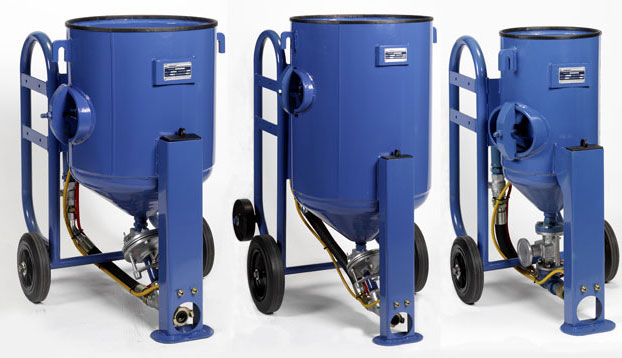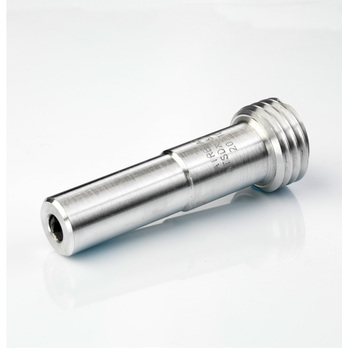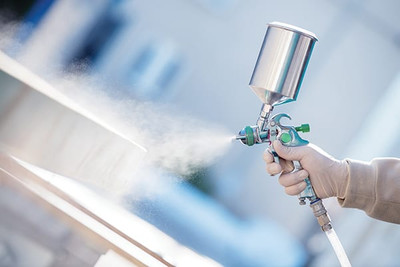Shotblasting is the process used to remove contaminants on metal surfaces. Normally, when we say contaminants, we mean rust, but it can also include paint and other coatings that need to come off. Shotblasting will change the smoothness or ‘profile’ of a metal surface and prepare it for finishing or painting.
We should note that ‘shotblasting’ is sometimes used as a general term, but technically refers to blasting with steel shot – a spherical media. Grit blasting usually refers to blasting with angular or part-angular media. To find out which abrasive you should use for your project, take a look at our blast media guide, or view individual descriptions of media types on our media page. Remember that sand blasting is illegal in the UK so you must use a silica-free abrasive.
But whichever media or abrasive you use, you’ll need a range of shotblasting equipment to ensure you can blast safely.
Small components
For small pieces of work, you should choose a blast cabinet. Blast cabinets are closed systems that use recyclable abrasive and allow you to control the process through integrated heavy-duty rubber gloves. There are three types of cabinet; pressurised, wheel or suction – the latter suction cabinet type blasts at lower pressures so is more appropriate for intermittent use where less air is required.
Larger components or structures

Blast Pot
A blast pot is a portable, compressor air-fed pneumatic machine available in a range of sizes. You will fill the blast pot with abrasive prior to use. The abrasive is held inside a pressurised vessel and then ejected through the blast hose controlled by the operator.

Blast Hose
An integral part of your shotblast equipment package is heavy duty blast hose to carry the abrasive from your pot (attached with a coupling) to the item you’re blasting. Usually, hose will be 1” or 1.1/4” inside diameter and comes in various lengths. Take a look at our Insider film page for a quick overview of blast hose maintenance.

Blast Nozzle
A blast nozzle will fix onto your blast hose via a nozzle holder. There are many types of blast nozzle, but they fall into two main categories; straight bore and Venturi – with various size and pattern variations in each. Deciding on the right blast nozzle size, shape and material durability depends on many factors including the size of your air compressor.
If you’re new to shotblasting and would like to learn more, our technical team are always on hand to answer your questions. Give them a shout or check out our Nozzles brochure for blast nozzle size data, and coupling assembly charts.

Deadman Handle
A deadman handle is an essential part of your shotblasting equipment kit. The deadman handle controls the air to the remote control valve and is held shut by the operator. Blasting starts when the handle is held closed and stops when it’s released – depressurising the blast machine and cutting the process completely (including if the handle is unintentionally released), hence the name deadman’s handle.
PPE
Difficult though it is to believe now, once upon a time (let’s call it the olden days), blasters would undertake shotblasting wearing very little or no PPE, or perhaps just a face shield to protect them from flying contaminants. Thankfully, those days are behind us and we now take PPE more seriously, underpinning safety with HSE legislation and industry best practice. Shotblasting is a dusty process whether you’re blasting inside or outside, and even wet blasting processes can create some dust. In short, if you’re shotblasting, you need to invest in good PPE. Let’s start with breathing…
 Breathing Equipment
Breathing Equipment
A breathing unit filters breathing air to remove any moisture and dust. Note that breathing units do not filter CO2 – you’ll need a gas monitor for that. Breathing units work in conjunction with blast helmets, hoods and respirators. You might want to stock up on a few accessories like extra lenses, tear-offs, head socks, a helmet breathing tube and a blast cape too.
You’ll also need a breathing air line or breathing air hose and connection fittings. Breathing air lines should have a non-toxic liner and comply with all safety standards. Get in touch with out technical team if you’d like us to check your breathing set-up.
Blast Suits and Gloves
Don’t start putting your shotblast equipment shopping list together without adding a blast suit and a pair of blast gloves. Protect your clothes and your skin with a heavy duty or lightweight suit and a pair of gloves, checking they’re well made from durable material like leather.
If you want to save money and you’re starting from scratch, you can buy a full Blast Pot Kit to get you going or create your own bespoke shotblast equipment list. Remember to take advice before you start blasting, undertake training if you’re a novice and refer to HSE guidance on abrasive blasting for more information.
This list of shotblast equipment is not exhaustive and may vary depending on the type of blasting you’re undertaking. Always take advice if you are new to shotblasting.




